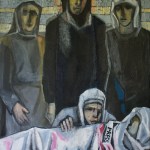
Published in Radio Haifa by Omer Mozer 20 March 2024 / translated from Hebrew
Dozens of paintings fill the studio of 82-year-old artist Abed Abdi in Wadi Nisnas. One of them, standing alone in a corner, distills 65 years of artistic creation intertwined with his personal story.
“This is the landscape of my childhood: the exit gate from the Port of Haifa, my father at the forefront of the painting, my mother and me hiding behind her,” he describes the piece, drawn in black lines.
“And hundreds of people walking behind my father, leaving their homeland — Haifa — on their way to the refugee camps in Syria. This is the refugeehood that has accompanied me all my life.”

He titled the painting “My Personal Nakba.”
His father’s gaze in the artwork reflects the terror that gripped him, his wife, their three daughters, and six-year-old Abed, as they were forced to flee Haifa in 1948 during the war.
“I personally went through the Nakba — and not only me. Out of 75,000 Arabs who were in Haifa, only 3,500 remained. My father was among those who managed to stay.”

How did your father manage to stay in Haifa?
“My father was a horse trader. He owned a khan (caravanserai) where the flea market stands today. He had a Jewish partner, a Polish man who spoke only Yiddish, named Haim.
Haim immediately helped my father stay, and not only that — he also helped him with the population registry documents, which eventually allowed us to return to Haifa after two and a half years of wandering, under the Family Reunification program.
It touched me deeply that a Jew helped my father — and it still moves me to this day.”

For you, the Nakba is our Independence Day. How do you reconcile that complexity?
“It’s difficult. It’s complicated. But I call for the recognition of rights, of pain, and of the Nakba we went through.
We must stop using destruction and aggression as a response, and seek a just solution for the two peoples living in this country.
There is a way to end this hostility between us — I don’t yet know what it is.
But art expresses the aspiration for a better state of being.”
What Abdi does know is how to paint. I catch him two days before his flight to Germany. He has been invited by the Frankfurt Museum to exhibit around 40 of his works, some of which he created while studying at the Academy of Fine Arts in Germany.
“I had a Jewish teacher there named Lea Grundig who influenced me deeply,” he recalls, drawing a symbolic line between his collaboration with Lea and the earlier help his family received.
“She came from a devout Jewish family — her father was a rabbi in Dresden — but she grew up in a communist youth movement.
Our encounter sparked a shared sense of empathy: she and her family had survived the Holocaust, and my family and I had survived the Nakba.”

For you – are art and politics inseparable?
“Artistic creation is inseparable from raising one’s voice — whether it’s a voice of protest or a voice of calm.”
That is reflected both in his past as an illustrator for the Arabic newspaper Al-Ittihad, and in his colorful paintings, which seem to offer a visual escape from reality.
“Art expresses my yearning for a better reality.”
Abdi remains busy, concerned, and engaged — both with the political situation in the country and with his personal status.
“People think of me as ‘that guy who came from the village, he’s not from here,'” he says.
“But I say: I am of the very flesh and blood of this city. My great-grandfather was born here. My mother’s uncle, Abed al-Rahman al-Haj, was mayor of Haifa between 1920 and 1927. I am a Palestinian from Haifa.”
Sometimes, I paid a price for saying that. But as long as I can think and respond to events through art — I will continue to do so.”



















